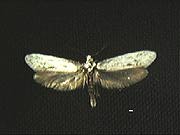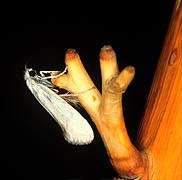Agavenema
Agavenema sp.
Olle PellmyrIntroduction
Frack (1982) stated that the following morphological traits distinguish Agavenema from Prodoxus:
- maxillary palps short
- proboscis short
- veins M1 and M2 stalked in hindwing (separate or connate in Prodoxus)
- pupal protrusion dorsoventrally flattened (conical/triangular in Prodoxus)
Brown et al. (1994) using a subset of Prodoxus species in a phylogenetic reconstruction based on DNA sequence data found Agavenema to be nested within Prodoxus. Further analyses currently under way should provide further resolution on this matter.
Species delineations within this genus are also contested. Davis (1967) recognized two species, A. barberella (Busck) and A. pallida Davis. Frack (1982) expressed reservations about this division, stating that it may represent one rather variable species or a complex of many sibling species. He recognized one distinct undescribed species (see top figure).
Because of the current uncertainty with regard to the genus status and species delineations, both described taxa are presented under this entry.
Adult Characteristics
A. barberella: Wing expanse 11-21 mm. Forewing near white, with numerous scattered dark brown spots and streaks. Hindwings medium to dark brown.
A. pallida: Wing expanse 17-25 mm. Forewing near white to light gray, with scattered dark brown spots and streaks, occasionally almost without maculation. Hindwings medium to dark brown.


A. pallida; Riverside Co., California
Comparison with Similar Species
Davis stated that A. pallida is a larger and paler species, that the vinculum and saccus in the male genitalia are relatively longer in pallida, and that pallida ovipositor serration is finer and with more teeth than in barberella. Frack suggested that intermediate states were found in more extensive material.
Host, Oviposition, and Larval Feeding Habits
Females oviposit into the stalks of several Agave species; A. barberella sensu Davis was confined to A. palmeri, whereas Frack reported five known hosts for the complex.
Geographic Distribution
Agavenema barberella sensu Davis was found in southeastern Arizona and A. pallida to southern California. Frack stated that he had seen material from California to Arizona, and southward into Baja California and mainland Mexico.
References
Brown, J.M., O.Pellmyr, J.N. Thompson & R.G.Harrison. 1994. Mitochondrial DNA phylogeny of the Prodoxidae (Lepidoptera: Incurvarioidea) indicates rapid ecological diversification of yucca moths. Ann. Entomol. Soc. Amer. 87:795-802.
Davis, D.R. 1967. A revision of the moths of the subfamily Prodoxinae (Lepidoptera: Incurvariidae). U.S. Nat. Hist. Mus., Bull. 255:1-170. Smiths. Contrib. Zool. 524:1-88.
Frack, D.C. 1982. A systematic study of prodoxine moths (Adelidae: Prodoxinae) and their hosts (Agavaceae), with descriptions of the subfamilies of Adelidae (s. lat.). M.S. thesis, California State Polytechnic University, Pomona, CA.
Title Illustrations

| Scientific Name | Agavenema sp. |
|---|---|
| Specimen Condition | Live Specimen |
| Image Use |
 This media file is licensed under the Creative Commons Attribution-NonCommercial License - Version 3.0. This media file is licensed under the Creative Commons Attribution-NonCommercial License - Version 3.0.
|
| Copyright |
© 1996

|
About This Page

University of Idaho, Moscow, Idaho, USA
Page copyright © 1996
 Page: Tree of Life
Agavenema . Agavenema sp..
Authored by
Olle Pellmyr.
The TEXT of this page is licensed under the
Creative Commons Attribution-NonCommercial License - Version 3.0. Note that images and other media
featured on this page are each governed by their own license, and they may or may not be available
for reuse. Click on an image or a media link to access the media data window, which provides the
relevant licensing information. For the general terms and conditions of ToL material reuse and
redistribution, please see the Tree of Life Copyright
Policies.
Page: Tree of Life
Agavenema . Agavenema sp..
Authored by
Olle Pellmyr.
The TEXT of this page is licensed under the
Creative Commons Attribution-NonCommercial License - Version 3.0. Note that images and other media
featured on this page are each governed by their own license, and they may or may not be available
for reuse. Click on an image or a media link to access the media data window, which provides the
relevant licensing information. For the general terms and conditions of ToL material reuse and
redistribution, please see the Tree of Life Copyright
Policies.
Citing this page:
Pellmyr, Olle. 1996. Agavenema . Agavenema sp.. Version 01 January 1996 (under construction). http://tolweb.org/Agavenema_sp./12423/1996.01.01 in The Tree of Life Web Project, http://tolweb.org/








 Go to quick links
Go to quick search
Go to navigation for this section of the ToL site
Go to detailed links for the ToL site
Go to quick links
Go to quick search
Go to navigation for this section of the ToL site
Go to detailed links for the ToL site